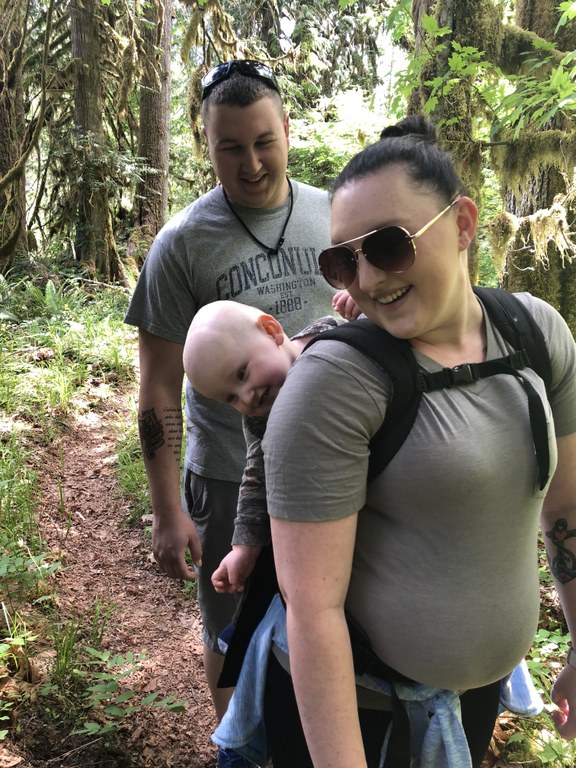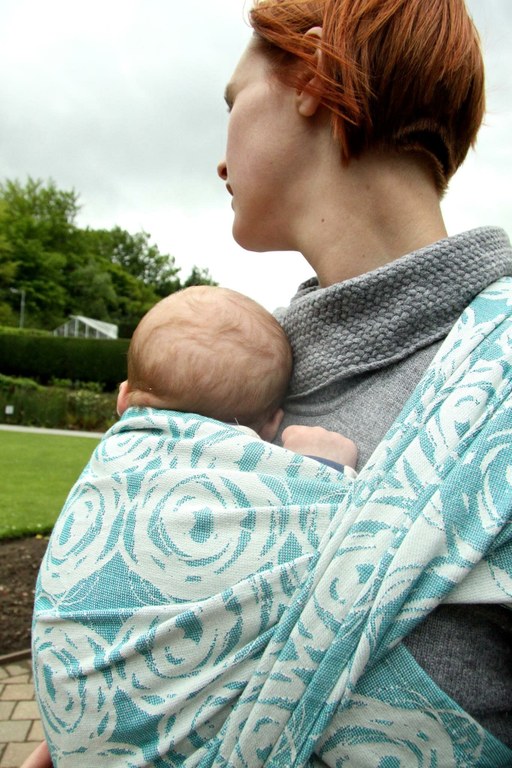Baby Carriers for the Trail: Pros and Cons of 5 Styles
If you love to hike, adding a baby or kid to the mix adds a whole new element to getting out on trail. You get to enjoy the wonder of nature through the eyes of a child. But you also have to haul that child around. Finding the right backpack or baby carrier can make all the difference.
Here are five styles of baby carriers that could help you and your family get out on trail until your kiddo is old enough to do all of the walking on their own.

A framed carrier is great for longer trips because it has room to carry some gear, too. Photo by Jessica Bora.
Framed backpack
What it is: A sturdy, solid backpack with a frame and solid structure. Framed backpacks usually have room for some gear Most backpacks can be used from the time a child can sit up and fit comfortably to whenever they outgrow the weight limit (often around 50 pounds, including any gear you’re carrying).
Pros: Framed backpacks are a good option if you are going to be doing a lot of hiking or if you plan to go backpacking. Because they have room for gear, they are useful if you will be hiking alone with your kid. Some packs have optional sun or rain protection. Many packs are adjustable, both for the size of the kid and the size of the adult. Many framed packs will stand up on their own, so you can gently take off a sleeping baby and give your back a rest while you stay nearby.
Cons: Framed packs are relatively heavy, and they take up a lot of space. They’re also not particularly useful beyond heading out for a walk or hike. They don’t work well around the house, for instance, making them less versatile than some other styles here.
Here are some of the options for framed backpacks:
- Deuter Kid Comfort 1
- Deuter Kid Comfort Pro
- Kelty Journey PerfectFIT
- Osprey Poco AG
- Osprey Poco AG Plus
- Thule Sapling
- Thule Sapling Elite

A soft structured carrier is versatile; it works well on trail and around town. Photo by Therese Corfee.
Soft structured carrier
What it is: A soft structured carrier has a waist belt and shoulder straps, with a sort of pocket that holds your kiddo close to your body. Most can be worn on the front of the body or, once the baby is big enough, can be worn on the back.
Pros: Can be used for a wide age-range of kids and by a wide size-range of adults. (For infants, you may need an insert that is sold separately.) For kiddos who are having a rough day, the option to carry them on your front may make for a happier kid. Structured carriers keep kids warm because they’re close to your body. They also pack reasonably small and are also useful for at home or in town.
Cons: These carriers don’t have much (if any) room to carry gear. Most are made out of cotton, so if they get wet, they dry slowly. (There are a few models that use synthetic materials.) If you wear the carrier on the front, it’s harder to see your feet, making rough trails trickier. They can get sweaty on hot days, because there is no separation between you and your child.
Here are some of the options for soft-structured carriers:

Minimeis let you carry your kiddo on your shoulders. Photo courtesy Minimeis.
Piggyback or shoulder carriers
What it is: There are a few styles of this type of carrier, which can make it easier to carry kids who are big enough to walk as if giving them a piggyback or letting them ride on your shoulders, but more securely.
Pros: These carriers are a fun option for kids who enjoy having a great view. They also work well for kids who might want to walk some and ride some. Most of them fold up reasonably small, making it possible to travel with them.
Cons: Depending upon the style, there might not be any storage space. They’re not ideal for use around your home. For carriers that put your kid on your shoulders, you’ll need to watch carefully for low hanging branches.
Here are some of the options for piggyback or shoulder carriers:

Ring slings are simple baby carriers that work for a variety of ages and will fit a variety of adults. Photo by Kristi Hayes-Devlin.
Sling
What it is: A sling is a large loop of fabric that is worn over one shoulder with the kiddo cradled against the adult’s body, either on the chest or off to one side. Most slings have a strip of fabric that you pull through a ring loop to tighten the carrier and make a good fit.
Pros: After you get past the learning curve, it’s easy to get a kiddo into and out of a sling. That makes them nice for a kid who wants to alternate between walking and being carried. Slings are compact and easy to travel with. They’re also useful for wearing around home or running errands, because it’s easy to pop a kiddo in and out.
Cons: Especially for small babies, you need to learn how to use a sling safely. Depending upon the sling, it may be uncomfortable to wear them with a backpack, although a fanny pack could work well. Most slings are cotton, and will dry slowly if they get wet.
Here are some of the options for ring slings:

A wrap offers many different options for carrying a baby or small child. Photo by pxfuel.
Wrap
What it is: A long piece of fabric that can be wrapped in a variety of ways to carry a baby or a kid on your front, hip or back, depending upon how you tie the wrap. Wraps can be made of stretchy material or woven, non-stretchy material. Stretchy material works better for babies, while non-stretch wraps can be used for both babies and larger kids.
Pros: Wraps — particularly woven wraps — are versatile, and can be tied in many different ways. Wraps pack up easily and double well as blankets or cloths to sit on the ground. They also work great in your home or around town.
Cons: Wraps have the steepest learning curve of the options here. Learning how to effectively wrap and tie them will take some time. Also, depending upon how you wear the wrap, it may be hard to wear a backpack. Most wraps are not made of quick-dry material. Stretchy wraps will need to be adjusted on longer hikes, as they tend to slowly sag as you move. Especially while you’re learning, wraps take time to take on and off, so they’re not ideal for a kid who wants to alternate being carried and walking.
Tips: Video tutorials could be helpful to give you an idea of the options with wraps.
Here are some of options for wraps:
Stretchy wraps:
Woven wraps:

